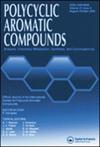Revealing the Anti-Cancer Potential of 1,2,3-Triazole-Isonicotinate Derivatives Targeting EGFR Kinase Inhibition in MCF-7 Cancer Cells: Design, Synthesis, Biological Evaluation, and In Silico Studies
IF 2.6
3区 化学
Q2 CHEMISTRY, ORGANIC
引用次数: 0
Abstract
Click chemistry was used to synthesize a new library of 1,2,3-triazole-isonicotinate derivatives 8–13 using copper(I)-catalyzed azide-alkyne cycloaddition (CuAAC) between mono- or bis 2,6-ethynylisonicotinate 3,4, and aromatic azides derivatives 5–7 with high yields (89–96%). These compounds were evaluated for their antiproliferative activity against hepatocellular carcinoma (Hep-G2), breast cancer (MCF-7), and colon cancer (HCT-116) cell lines, alongside a healthy non-cancerous skin fibroblast cell line (BJ-1). As compared with the reference drug, all new triazole-isonicotinate compounds have significantly greater cytotoxicity against colon and breast cancer cells, while compounds 13 and 10 have moderate cytotoxicity against liver cancer cells. The molecular docking study correlates the compound’s biological activity with its ability to establish stable interactions with protein-ligand complexes in the relevant biological targets. Compound 13 demonstrated a strong ability to induce apoptosis and cause cell cycle arrest in MCF-7 cells, along with significant inhibitory activity against the epidermal growth factor receptor (EGFR). These preliminary findings suggest that 1,2,3-triazole-isonicotinate derivatives, particularly compound 13, hold potential as candidates for further investigation as anticancer agents for breast cancer treatment.
揭示靶向MCF-7癌细胞中EGFR激酶抑制的1,2,3-三唑-异烟酸衍生物的抗癌潜力:设计、合成、生物学评价和计算机研究
利用Click化学方法,利用铜(I)催化叠氮化物-炔环加成(CuAAC),在单-或双2,6-乙基异烟酸3,4和芳香叠氮化物衍生物5-7之间合成了1,2,3-三唑-异烟酸衍生物8-13,收率高(89-96%)。这些化合物对肝细胞癌(Hep-G2)、乳腺癌(MCF-7)和结肠癌(HCT-116)细胞系以及健康的非癌性皮肤成纤维细胞系(BJ-1)的抗增殖活性进行了评估。与参比药物相比,所有新的三唑-异烟酸化合物对结肠癌和乳腺癌细胞的细胞毒性均显著增强,而化合物13和10对肝癌细胞的细胞毒性中等。分子对接研究将化合物的生物活性与其在相关生物靶标中与蛋白质-配体复合物建立稳定相互作用的能力联系起来。化合物13在MCF-7细胞中表现出很强的诱导凋亡和细胞周期阻滞的能力,同时对表皮生长因子受体(EGFR)具有显著的抑制活性。这些初步研究结果表明,1,2,3-三唑-异烟酸酯衍生物,特别是化合物13,作为乳腺癌治疗的抗癌药物,具有进一步研究的潜力。
本文章由计算机程序翻译,如有差异,请以英文原文为准。
求助全文
约1分钟内获得全文
求助全文
来源期刊

Polycyclic Aromatic Compounds
化学-有机化学
CiteScore
3.70
自引率
20.80%
发文量
412
审稿时长
3 months
期刊介绍:
The purpose of Polycyclic Aromatic Compounds is to provide an international and interdisciplinary forum for all aspects of research related to polycyclic aromatic compounds (PAC). Topics range from fundamental research in chemistry (including synthetic and theoretical chemistry) and physics (including astrophysics), as well as thermodynamics, spectroscopy, analytical methods, and biology to applied studies in environmental science, biochemistry, toxicology, and industry. Polycyclic Aromatic Compounds has an outstanding Editorial Board and offers a rapid and efficient peer review process, as well as a flexible open access policy.
 求助内容:
求助内容: 应助结果提醒方式:
应助结果提醒方式:


